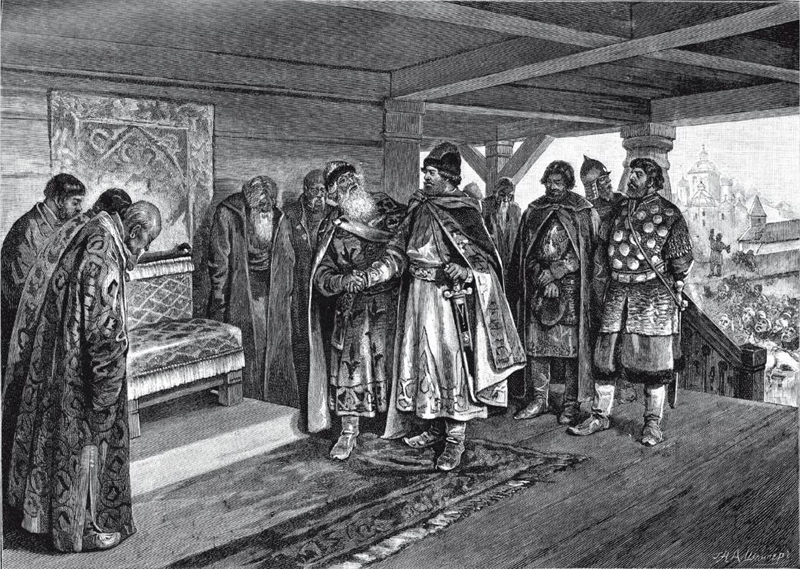The wars' effect on the Finns' society contributed to the eventual Swedish conquest of western Finland in around 1249. The term used in Russian chronicles to refer to Novgorod's enemy, Yem, is unclear and probably referred to several different groups, even though etymologically it derives from the Finnish word Häme, which means Tavastia / Tavastland (= later Birkaland, and today is Häme).
Some of the groups identified as Yem may have been the inhabitants of Tavastland in south-central Finland, the West Finns in general, or a sub-group of Karelians on the northern coast of the Ladoga who descended from western Finns who had moved to the area earlier.

Novgorod area.
The only known written sources on the Yem-Novgorodian wars are contained in the medieval Russian chronicles. The Russians and Yem had frequent conflicts from the 11th or 12th century onwards. The eastern Finnic peoples Votes, Korela (interpreted as Karelians in general or more specifically as the Karelians on the southwest coast of the Ladoga) and Izhorians are all mentioned as allies of Novgorod, said to have been fighting against the Yem even without Novgorod's direct involvement, possibly over control of land area in central and eastern Finland; this territorial feud manifested in annual retaliatory expeditions that featured merciless treatment of the settlers of the opposing tribe.
The earliest possible mention of hostilities is from the Laurentian Codex which records in passing that the Novgorodian Prince Vladimir Yaroslavich was at war with the "Yam" in 1042 AD. The Yam are also mentioned as tributaries to Novgorod in the Primary Chronicle, but they disappear from sources later on.
Conflicts certainly began in the early 12th century, however information on them remains very scarce.

According to the Novgorod First Chronicle, another Prince of Novgorod, Vsevolod Mstislavich, and his troops from Novgorod were at war with Yem during a great famine in 1123. The chronicle leaves any further developments of the conflict open, including the whereabouts of the fight.
Yem pillaged Novgorodian territory in 1142, but were defeated near Ladoga with 400 casualties. Coincidentally or not, Swedes attacked the Novgorodians in the same year as well. The Korela, now under Novgorodian influence, were at war with Yem in the following year, but were forced to flee, losing two ships.
Yem attacked Russian soil again in 1149 with 1000 men. Novgorodians, totaling 500, went in pursuit of the Yem, utterly defeating them with Votes, a Finnic tribe in alliance with Novgorod. Votes, today almost extinct, lived south of the present-day Saint Petersburg, probably making this the deepest attack that Yem ever made into Russian territory.
Yem = Dzhem = Tsuhna = Tsuudi = Hurri (sobriquet to finn, use like winter war)
Hurri, = person or peoples who forest resident (aborigine).
After a long pause in open hostilities -at least in the chronicles- a Novgorodian called Vyshata Vasilyevich led his troops against Yem in 1186, returning unharmed with prisoners. It is not clear whether he took his forces to fight in the land of Yem or to defend his country against an intrusion. Reasons for the renewed fighting have not been identified.
Korela accompanied Novgorodians for yet another attack against the Yem in 1191. This time the fighting is clearly said to have taken place "the land of the Yem", the first such entry in Russian chronicles. The assailants "burned the country and killed the cattle". Very hypothetically this may have been the same attack that was mentioned in a much later Swedish chronicle, the mid-16th century Chronicon episcoporum Finlandensium by Bishop Paulus Juusten, that records the Russians burning "Turku" in 1198, at the time of Bishop Folquinus. Russian chronicles have no information about a conflict that year. It should be noted that the town of Turku did not exist before the end of the 13th century.
----
At the same time, Sweden and Novgorod were in conflict as well. Pope Alexander III, in his letter to the Archbishop of Uppsala and Jarl Gottorm of Sweden in 1171 (or 1172), perhaps refers to the Finns' struggle against Novgorod by demanding Sweden take over Finnish fortresses in exchange for protection.
In the late 15th century, historian Ericus Olai claimed that Bishop Kol of Linköping (died c. 1196) had been the "Jarl of Finland" (Dux Finlandiae), possibly leading Swedish troops temporarily situated in Finland. He may have been in a military role similar to that of Jon Jarl, who allegedly spent nine years overseas fighting against Novgorodians and Ingrians at the end of the 12th century.
Also noteworthy is the so-called First Swedish Crusade, which, according to several 15th-century sources, took place in 1150. The crusade is only known from later legends that presented the expedition (if it ever took place) as a Christian mission, headed by a saint king to baptize heathens. However, it seems to have followed the exceptionally edgy 1140s with both the Yem and Swedes fighting against Novgorod. Some historians have seen it as a direct reaction to the failed Yem expedition in 1149, associating it with the co-operation mentioned by the Pope 20 years later.
----
In 1221, Pope Honorius III was again worried about the situation after receiving alarming information from the Archbishop of Uppsala. He authorized the unnamed Bishop of Finland to establish a trade embargo against the "barbarians" that threatened the Christianity in Finland. The nationality of the "barbarians", presumably a citation from Archbishop's earlier letter, remains unknown, and was not necessarily known even by the Pope. However, as the trade embargo was widened eight years later, it was specifically said to be against the Russians.
Russian sources mention Swedish-Yem co-operation in 1240 at the earliest; it was then that were mentioned as one of the Swedes' allies in the little-documented Battle of the Neva.
The first reliable mention of Yem being a part of Swedish forces is from 1256, seven years after the conventional dating of the so-called Second Swedish Crusade.


Great read
VastaaPoistaThanks, my friend.
PoistaA little background to the Finnish - Swedish, and Novgorod-Russian Triangle areas